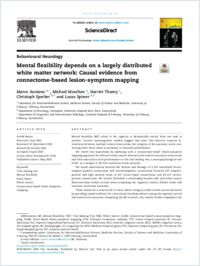Mental flexibility depends on a largely distributed white matter network: Causal evidence from connectome-based lesion-symptom mapping
DOKPE
- Anziano, Marco University of Fribourg
- Mouthon, Michael University of Fribourg
- Thoeny, Harriet University of Fribourg
- Sperber, Christoph University Hospital Bern
- 05.05.2023
Published in:
- Cortex. - Elsevier BV. - 2023, vol. 165, p. 38-56
Trail making test
Mental flexibility
Brain lesion
White matter
Connectome-based lesion symptom mapping
English
Mental flexibility (MF) refers to the capacity to dynamically switch from one task to
another. Current neurocognitive models suggest that since this function requires interactions between multiple remote brain areas, the integrity of the anatomic tracts connecting these brain areas is necessary to maintain performance.
We tested this hypothesis by assessing with a connectome-based lesion-symptom
mapping approach the effects of white matter lesions on the brain’s structural connectome and their association with performance on the trail making test, a neuropsychological test of MF, in a sample of 167 first unilateral stroke patients.
We found associations between MF deficits and damage of i) left lateralized fronto-temporo-parietal connections and interhemispheric connections between left temporoparietal and right parietal areas; ii) left cortico-basal connections; and iii) left corticopontine connections. We further identified a relationship between MF and white matter disconnections within cortical areas composing the cognitive control, default mode and attention functional networks.
These results for a central role of white matter integrity in MF extend current literature
by providing causal evidence for a functional interdependence among the regional cortical and subcortical structures composing the MF network. Our results further emphasize the necessity to consider connectomics in lesion-symptom mapping analyses to establish comprehensive neurocognitive models of high-order cognitive functions.
another. Current neurocognitive models suggest that since this function requires interactions between multiple remote brain areas, the integrity of the anatomic tracts connecting these brain areas is necessary to maintain performance.
We tested this hypothesis by assessing with a connectome-based lesion-symptom
mapping approach the effects of white matter lesions on the brain’s structural connectome and their association with performance on the trail making test, a neuropsychological test of MF, in a sample of 167 first unilateral stroke patients.
We found associations between MF deficits and damage of i) left lateralized fronto-temporo-parietal connections and interhemispheric connections between left temporoparietal and right parietal areas; ii) left cortico-basal connections; and iii) left corticopontine connections. We further identified a relationship between MF and white matter disconnections within cortical areas composing the cognitive control, default mode and attention functional networks.
These results for a central role of white matter integrity in MF extend current literature
by providing causal evidence for a functional interdependence among the regional cortical and subcortical structures composing the MF network. Our results further emphasize the necessity to consider connectomics in lesion-symptom mapping analyses to establish comprehensive neurocognitive models of high-order cognitive functions.
- Faculty
- Faculté des sciences et de médecine
- Department
- Médecine 3ème année
- Language
-
- English
- License
- CC BY
- Open access status
- hybrid
- Identifiers
-
- DOI 10.1016/j.cortex.2023.04.007
- ISSN 0010-9452
- Persistent URL
- https://folia.unifr.ch/unifr/documents/326099
Statistics
Document views: 54
File downloads:
- cortex_anziano_2023.pdf: 114
